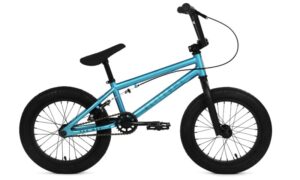In a world of constant movement, where progress zooms by at lightning speed, there is a simple, enduring companion that has stood the test of time—the bicycle. A marvel of human ingenuity and a symbol of freedom, the bike has been propelling us forward for centuries.
From the quaint city streets to the rugged mountain trails, bikes have been there, faithfully carrying us on countless adventures. But as we pedal through life, a question arises: how long do bikes last or what is the average lifespan of a bike?
Buckle up and join me on a journey as I unravel the average lifespan of a bike, exploring the factors that shape its destiny and discovering the secrets that allow it to endure through the winds of time.
How Long Do Bikes Last: Average Lifespan of a Common Bike
The average lifespan of a common bike can vary depending on several factors, including the quality of the bike, how well it is maintained, and the type of usage it undergoes.
Generally, a well-maintained bike can last for many years. With regular maintenance and proper care, a bike can easily last anywhere from 5 to 10 years or more. However, it’s important to note that this is just an average estimate, and individual experiences may vary.
Exploring Different Types of Bicycles: A Comprehensive Overview
At present, there exists a wide range of bicycle types that can be classified based on their design or intended purpose. Below are some of the most prevalent types that you can typically find at your local bicycle store:
1. Road Bike

Road bicycles are typically lightweight and designed for use on paved or gravel roads. Due to their construction, they are not recommended for off-road trails.
The average lifespan of a road bike: 5-10 years.
2. Mountain Bikes (MTB)

Mountain bikes are specifically built to handle challenging terrains, providing a smoother experience compared to regular bicycles. They also have subcategories tailored for various activities, including Cross Country Bikes, Trail Bikes, and more.
The average lifespan of a mountain bike: over 20 years.
3. Folding Bike

Ideal for travel and leisure rides, folding bicycles can be conveniently folded into a compact frame for easy storage and transportation.
The average lifespan of a folding bike: 15-20 years.
4. Hybrid Bike

Hybrid bikes combine features from different bike types, making them versatile and suitable for various purposes. They are well-suited for leisurely rides in town and some casual off-road adventures.
The average lifespan of a bike: up to 5 years or more.
5. BMX

BMX bikes compact-framed bicycles are commonly favored by riders who enjoy performing tricks and participating in short dirt races.
The average lifespan of a BMX bike: 2-6 years.
6. Fixies / Single Gear Bikes

As their name suggests, these bicycles have only one fixed gear, causing the rear wheel to move in sync with the pedal, whether it’s forward or backward.
The average lifespan of a bike: up to 5 years or more.
7. Electric Bike

Electric bikes, powered by electricity, provide assistance and support, especially when tackling uphill climbs, for quicker travel.
The average lifespan of an electric bike: 3-5 years.
8. Tandem Bikes

Unique in design, tandem bicycles can accommodate two or more riders. These bikes are suitable for individuals who are physically fit and have disabilities, as well as children and elderly individuals.
The average lifespan of a bike: 10 years.
9. Touring Bike
These robust bicycles are designed to carry heavy loads. They feature multiple attachment points, allowing for secure baggage packing at the front or back.
The average lifespan of a touring bike: up to 5 years to a lifetime.
10. Fat Bike

Specifically built to traverse snowy, muddy, and rocky terrains with exceptional stability, fat tire bikes have wide, thick tires that easily conquer obstacles.
The average lifespan of a fat bike: 2,500 miles – 3,000 miles.
How Long Does a Bicycle Last: Lifespan of Various Components of a Bike
The lifespan of bicycle components can be measured in terms of mileage or distance covered, whether in kilometers or meters. Take a look at the approximate estimates provided below:
| Parts | Average Lifespan |
| Bike Chain | 1,500 – 2,000 miles |
| Bike Cassette | 3,000 – 5,000 miles |
| Freehub | 5,000+ miles |
| Wheels/Tires | 3,000 – 6,000 miles |
| Brake Pads (based on wet or dry condition) | 500 – 7,500 miles |
| Belt Drive | 20,000+ miles |
| Spokes | 186,400 miles, maybe forever in quality wheels |
| Aluminum Handlebar | 18,600 miles |
| Aluminum Crankset | 18,600 miles |
Essential Components to Replace in Bike Due to Aging Factor
1. How Long Do Bikes Frame Last
The bike frame serves as the fundamental building block of your bicycle. Without a frame, you simply do not have a functional bike.
Aluminum
Aluminum frames are characterized by their lightweight nature and responsiveness. They offer a cost-effective choice, but their lifespan with regular use is typically around six years. Once an aluminium frame develops cracks, it becomes unfit for riding.
Steel
Steel bike frames are highly regarded for their exceptional strength; however, they come with added weight. Steel frames are prone to rust, particularly from the inside out. The lifespan of a steel frame is also approximately six years.
Titanium
Titanium frames boast exceptional durability and are resistant to corrosion, unlike steel frames. Additionally, they are lightweight. However, they tend to be more expensive. A titanium frame can last an extended period, with a lifespan of up to 40 years.
Carbon
A carbon frame has an estimated lifespan of ten years or more. Some individuals claim that with proper care, carbon frames can last indefinitely.
Carbon fiber technology is relatively new to the cycling industry compared to other frame materials, and I am continually discovering its capabilities and longevity. It’s worth noting that early carbon bikes were constructed differently, and their frames may not endure as long as contemporary carbon frames.
2. How Long Do Bikes Tire Last
Tires used regularly on road bikes typically have an approximate lifespan of 2,000 miles. However, puncture-resistant models can last up to 3,000 miles due to their harder-wearing construction.
Note: Most tires can be stored for up to 3 years without encountering any issues.
The longevity of tires can vary significantly, often attributed to rider behavior. For example, if you apply excessive force to your rear brake, you may experience a shorter tire lifespan compared to the average 2,000 miles.
During storage, tires gradually undergo degradation. Factors such as heat, exposure to UV light, and extreme cold can all contribute to this process over time. Storing bike tires is a straightforward task, although different manufacturers may provide slightly varied recommendations.
To maintain a three-year lifespan, it is crucial to minimize heat, light, and moisture exposure while storing the tires. Additionally, it is advisable to place them on a rim and keep them inflated while in storage. This practice helps preserve their integrity.
3. How Long Do Bikes Inner Tubes Last
On average, inner tubes tend to last approximately 500 miles, and Continental recommends replacing them every three years as a reliable guideline. However, when stored under ideal conditions, inner tubes can last for a decade or even longer.
Most often, inner tubes meet their end due to punctures from sharp objects before the rubber ages sufficiently to warrant replacement.
During storage, inner tubes have the potential to last an extended period. The same ideal conditions applicable to tires should be maintained. Additionally, inner tubes can be stored in plastic bags, as they are small enough to be conveniently bundled.
If an inner tube has been stored for more than three years, it is advisable to inflate it without attaching it to a tire and assess its condition before installing it on your bike. In real-world scenarios, people have used tubes that are over ten years old without encountering any issues.
4. How Long Do Bikes Chain Last
Bicycle chains naturally experience stretching as they are used, and it is generally recommended to replace them after covering approximately 750 to 1000 miles. Beyond this point, the chain will have elongated, leading to increased wear on other bike components.
Proper chain maintenance plays a vital role in preserving the overall condition of your bicycle, yet many beginners tend to overlook it until they experience their first chain breakage.
5. How Long Do Bikes Brake Pads Last
The lifespan of decent bike brake pads typically ranges from a few hundred miles to 1,500 miles. However, the exact duration can vary based on factors such as the brake type (disc vs rim), pad material, riding style, personal braking technique, and more. It is always advisable to exercise caution when it comes to brake pads.
It’s worth noting that most brake pads become ineffective when exposed to oil. While you can try using a solvent like rubbing alcohol to remove oil, it’s best to avoid oil contact altogether. This includes being mindful of natural oils on your hands, so handle new pads with minimal contact when installing them on the bike.
Riding with damaged or worn brake pads can lead to hazardous situations. Therefore, it is essential to exercise caution, and when in doubt, it is recommended to replace your brake pads promptly.
6. How Long Do Bikes Brake Cables Last
It is advisable to replace bike cables approximately once a year or after covering 5,000 miles, depending on whichever occurs first. While cables tend to have a longer lifespan compared to other bike components, they play a crucial role in the braking system.
Neglected cables can result in accidents, so it is recommended to proactively replace them as part of routine maintenance rather than waiting for them to fail.
7. How Long Do Bikes Wheels / Rims Last
The duration of a bicycle rim can greatly differ. It could endure anywhere between 1,500 to 10,000+ miles before experiencing deterioration. Regular inspections are highly recommended as the most effective way to determine their condition.
The longevity of rims depends on various factors, such as the rider’s weight, riding style, and rim maintenance. However, the most significant factor is braking, as it gradually wears down the rim material. Prolonging rim lifespan can be achieved by practicing restrained use of brakes.
To identify the need for a replacement, be vigilant for concave surfaces on the rim. When the rim is no longer straight and exhibits this concave edge, it indicates the time to consider getting a new one.
Identifying this concavity can be challenging without prior knowledge, so it is advisable to seek examples that can guide you in the right direction.
8. How Long Do Bikes Cassettes Last
The guidelines for bike cassettes may differ, but typically, it is advisable to replace them with every other chain replacement. However, performance-oriented riders often opt to change the cassette every time they replace the chain.
Based on my experience, it has been satisfactory to replace the cassette approximately every two or three chains replacements. The key aspect to monitor is any skipping that occurs on the cassette while pedaling vigorously.
If skipping is observed even with a relatively new chain, it indicates the need to replace the cassette.
How Long Do Bicycles Last: Factors Influencing the Lifespan of a Bicycle
The durability of a bicycle is determined not only by its inherent quality but also by various external factors, such as frequency of use and the level of maintenance it receives. Please refer to the following information for more details.
1. Manufacturer & Care
The lifespan of a bicycle is heavily influenced by its manufacturer and the level of care it receives. A well-made bike, when properly maintained, can endure for many years. Conversely, a low-budget bicycle constructed with subpar materials will require replacement sooner.
Additionally, if your bike sustains frequent damage or if you neglect regular cleaning, the components may wear out rapidly or even break, resulting in a shorter overall lifespan.
2. Travel Distance and Path
For a newly purchased bike used for daily long-distance commuting, it can last for an average of 4 years. However, if the bike is primarily used for shorter distances, its lifespan can extend up to an impressive 30 years.
3. Overall Damage from Wear and Tear
Rocks, dirt, and accumulated filth have the potential to harm your bicycle, particularly if not promptly addressed and resolved.
Assuming your bike does not have any cracks or damaged components, it is likely to endure for numerous years. However, if your bike was utilized for racing purposes and exposed to severe weather conditions, the frame might experience accelerated deterioration compared to standard circumstances.
4. Quality of the Bike
The quality of the bike you purchase plays a significant role in determining its lifespan. For instance, a budget-friendly bike from a store like Walmart may only endure for a couple of years. However, with diligent maintenance, you might be able to extend its lifespan to around 5 years.
Conversely, a high-quality carbon-fiber bike, if properly maintained and stored, has the potential to last indefinitely. Superior materials and components used in higher-quality bikes enhance their performance and longevity.
5. Types of Bike
The type of bike you choose can also impact its lifespan. For instance, mountain bikes are designed to withstand rugged conditions and endure impacts, so a gently used mountain bike is likely to have a longer lifespan compared to a road bike with more delicate components that have been roughly used.
On the other hand, children’s bikes are typically designed to last for a few years until they are outgrown and replaced with larger models.
6. Riding and Storage Conditions
The conditions in which you ride and store your bike also influence its longevity. Frequent exposure to rain, mud, and grit will accelerate the wear and tear on your bike compared to riding in pleasant weather conditions on smooth, well-maintained roads.
Likewise, storing your bike indoors, where it is shielded from adverse weather, will significantly extend its lifespan compared to leaving it regularly exposed to rain outdoors. Protecting your bike from unfavorable weather conditions is essential for prolonging its lifespan.
Ways to Increase the Lifespan of a Bike and Its Components
If you aim to maximize the benefits of your bicycle, both in terms of health advantages and return on investment, there are simple methods to prolong its lifespan. Here are some suggestions:
1. Opt for Quality
As mentioned previously, choosing a high-quality bike will significantly extend its life expectancy compared to a bike from a department store. Not only will the riding experience be vastly different, but a quality bike is also a worthwhile investment.
While you don’t need to splurge on the most expensive option, investing around $600 can get you a great bike. For instance, the FX1 Disc, available in this price range, is an excellent choice for commuters. It offers exceptional comfort and surpasses department store bikes that are half its price.
2. Proper Storage
A bike that is constantly exposed to the elements will age much faster than one protected from them. While you don’t need to keep your bike in a heated garage, simply safeguarding it from rain and snow can make a significant difference in its longevity.
3. Regular Cleaning
While it’s not necessary to obsess over every speck of dust or minor dirt on your bike’s surface, neglecting grime and salty water can damage its components and reduce its lifespan.
Especially if you reside in an area with snowy winters, keeping your bike reasonably clean will have a considerable impact on its overall condition.
4. Timely Replacement of Worn Parts
Components such as the chain, cassette, brake pads, and bearings are moving parts that require regular maintenance. It is important to monitor their condition and replace them when necessary.
If you prefer not to handle this yourself, consider taking your bike to a local bike shop for a tune-up once or twice a year, depending on your usage.
5. Lubricate
Keeping your chain clean and properly lubricated is a simple yet effective way to enhance your riding experience. It only takes a few minutes but offers long-lasting benefits. Investing in a reliable chain cleaning tool, such as the one available from ParkTool, can significantly streamline the entire process.
Which Bikes Last the Longest
There is no single type of bicycle that universally outlasts all others. However, it is most commonly observed that steel-frame city bikes can remain in service for several decades.
These bikes are often constructed with heavy, thick-walled tubes that are resistant to impacts and dents, allowing them to last indefinitely with proper maintenance and occasional replacement of minor wear-and-tear parts.
It’s important to distinguish between the longest lifespan of a bike and the longest duration without maintenance. Even an exceptionally durable traditional city bike still requires chain care, while good belt-drive bicycles can go years without drivetrain maintenance.
How many Miles Can you Get Out of a Bicycle
There is no fixed limit to how many miles a bike itself can last, as individual parts wear out at different intervals. For instance, a chain may need replacement every 1,500 miles, while tires may last around 3,000 miles.
However, components like bottom brackets can often endure several years before requiring replacement.
By replacing these worn parts as needed, your bike can essentially last indefinitely, assuming it doesn’t suffer major damage or develop cracks due to a crash. It’s important to note that heavier or more aggressive riders will experience quicker wear on the same parts.
What’s “High Mileage” for a Bicycle
One could consider a bicycle to have “high mileage” after reaching 10,000 miles or more. By that point, most drivetrain parts and tires have likely been replaced at least a couple of times. This typically corresponds to 2-5 years of regular use.
However, in practical terms, cyclists often do not think of mileage alone, as not all miles are equal. For example, 1,000 miles of riding on wet gravel roads with a heavy rider and loaded cargo can cause more wear than 5,000 miles of a child cruising along sunny streets.
Furthermore, mileage is less of a concern for bicycles and other non-motorized vehicles.
Why Cheap Bikes Don’t Last as Long
Lower-priced bicycles, such as those found in department stores and big-box retailers, often experience issues within the initial rides. These problems typically arise from improper assembly rather than inherent flaws in the bike’s quality.
However, extremely inexpensive bikes may also have subpar internal components like a headset or hub bearings, which can develop issues within a few months, whereas higher-quality bikes may not encounter such problems for years.
Fortunately, the bar for “better bikes” isn’t set too high. For around $500, you can purchase a reasonably priced bike from a reputable brand at a bicycle shop.
Such bikes should last the average commuter or recreational rider 6-12 months without requiring extensive maintenance, aside from routine tasks like chain lubrication, tire inflation, and cable tension adjustment.
Is My Bike Worth Fixing
If your bicycle is comfortable, meets your needs, and doesn’t belong to a low-end brand or a big-box store, it’s worth considering repairs. However, if the frame is cracked, dented, rusty, or corroded, it’s generally not worth fixing.
Before committing to bike repairs, always consult your local bike shop for an estimate. Extensive repairs involving parts and labor can often exceed the cost of a new bike.
Bike shops typically charge around $60-$100 per hour for labor, and they may have fixed prices for common services such as specific part installations or general tune-ups. Additionally, you’ll need to cover the retail price of any parts or accessories used during the repair.
If multiple components of your bike require replacement or major repairs, the cost can quickly add up to several hundred dollars. In such cases, it may be more cost-effective to replace your bike entirely, especially if the old one doesn’t hold much value.
However, even if your bike isn’t worth much, it doesn’t necessarily mean it’s destined for the landfill. Many charitable organizations accept repairable bikes, refurbish them, and donate them to those in need. Seattle’s Bike Works is one well-known example, but similar organizations exist worldwide.
It’s important to note that certain parts of the bike will need to be replaced periodically, regardless of the bike’s price range. Whether you own a $400 or a $4,000 bike, there are components designed to be replaced over time.
For those seeking a durable bike on a budget, traditional steel-frame city bikes like the Brooklyn Franklin are worth considering. Alternatively, if price is not a concern, you have a wide range of boutique brands to choose from, offering high-quality models that can potentially last a lifetime.
Summing Up — Average Lifespan of a Bike
Ultimately, the lifespan of a bike can be extended through proper maintenance, regular inspections, and timely repairs.
By investing time and effort into keeping the bike in good working order, enthusiasts can enjoy their two-wheeled companions for a significant period, allowing them to explore, commute, and experience the joys of cycling for years to come.
Please share your thoughts and feedback on the article in the comments section. Please like, share, and follow our Facebook Page, and keep visiting our website for more guides like this.
How Long Do Bikes Last — Frequently Asked Questions
Do Bikes Have a Lifetime Warranty?
The majority of bicycles come with a manufacturer’s warranty, which typically ranges from 1 to 5 years. However, the specific terms and coverage vary depending on the bike manufacturer and their policies.
In certain cases, if you discover a reputable store, they may provide a lifetime warranty, although it usually applies only to specific components like the frame and fork. As an example, Trek Bikes offers a lifetime warranty specifically for their frame sets.
When is a Bicycle Considered Vintage?
Bicycles that are over 25 years old are generally considered vintage, while those manufactured before the 1920s are classified as antique. Although “vintage” may imply “old” or “outdated” for a bicycle, a well-maintained bike can still perform admirably even after 25 years.
If you’re on a budget and considering purchasing a bike, it’s worth exploring second-hand options from reputable brands. Most bikes significantly depreciate in value, and you can expect to pay around £200 for a decent used bike from a quality brand.
It’s not uncommon to find bikes being sold for less than half their original retail price after just a couple of years.
However, certain bikes retain their value due to reputation and desirability. It would be exceptionally rare to come across a cheap second-hand Pinarello or Canyon bike for sale. But if you did, it would indeed be a great bargain.
When Should You Get a New Bike?
There are multiple factors that might prompt you to consider acquiring a new bicycle. One reason could be practicality, such as incorrect sizing or geometry. Your cycling requirements may have changed, such as the distance or location of your rides.
Alternatively, your current bike might be in a dire state of disrepair, or perhaps you simply desire an improved or more recent model.
Determining “when” to get a new bike can be subjective and dependent on various factors. If the bike fits you well, meets your riding needs, and is properly maintained, it should endure for as long as you desire unless the frame is damaged.
Related:
